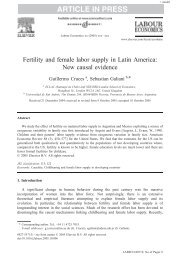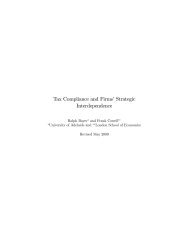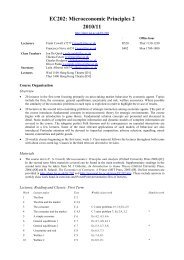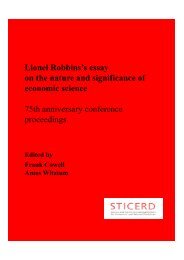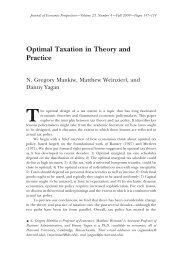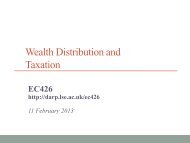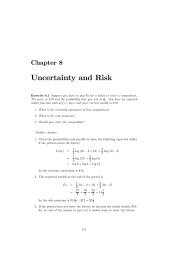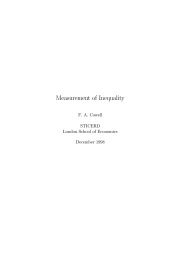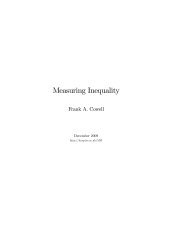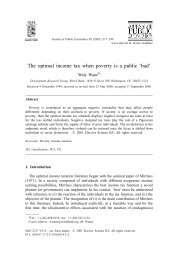- Page 1: Measuring InequalityFrank A. Cowell
- Page 6 and 7: viLIST OF TABLES
- Page 9 and 10: LIST OF FIGURESix5.17 The Atkinson
- Page 13 and 14: xiiidating the literature notes and
- Page 15 and 16: Chapter 1First Principles“It is b
- Page 17: 1.1. A PREVIEW OF THE BOOK 31.1 A p
- Page 20 and 21: 6 CHAPTER 1. FIRST PRINCIPLESthe po
- Page 22 and 23: 8 CHAPTER 1. FIRST PRINCIPLEStype
- Page 24 and 25: 10 CHAPTER 1. FIRST PRINCIPLESequiv
- Page 26 and 27: 12 CHAPTER 1. FIRST PRINCIPLESmark
- Page 28 and 29: 14 CHAPTER 1. FIRST PRINCIPLESmonth
- Page 33: 2.1. DIAGRAMS 19UK Income Before Ta
- Page 38 and 39: 24 CHAPTER 2. CHARTING INEQUALITYra
- Page 40 and 41: 26 CHAPTER 2. CHARTING INEQUALITYas
- Page 42 and 43: 28 CHAPTER 2. CHARTING INEQUALITYwi
- Page 44 and 45: 30 CHAPTER 2. CHARTING INEQUALITYto
- Page 46 and 47: 32 CHAPTER 2. CHARTING INEQUALITYFi
- Page 48 and 49: 34 CHAPTER 2. CHARTING INEQUALITYsi
- Page 50 and 51: 36 CHAPTER 2. CHARTING INEQUALITY2.
- Page 52 and 53: 38 CHAPTER 2. CHARTING INEQUALITY U
- Page 54 and 55: 40 CHAPTER 3. ANALYSING INEQUALITYt
- Page 56 and 57: 42 CHAPTER 3. ANALYSING INEQUALITYa
- Page 58 and 59: 44 CHAPTER 3. ANALYSING INEQUALITYU
- Page 60 and 61: 46 CHAPTER 3. ANALYSING INEQUALITYS
- Page 62 and 63: 48 CHAPTER 3. ANALYSING INEQUALITYm
- Page 64 and 65: 50 CHAPTER 3. ANALYSING INEQUALITYF
- Page 66 and 67: 52 CHAPTER 3. ANALYSING INEQUALITYr
- Page 68 and 69: 54 CHAPTER 3. ANALYSING INEQUALITYf
- Page 70 and 71: 56 CHAPTER 3. ANALYSING INEQUALITYF
- Page 72 and 73: 58 CHAPTER 3. ANALYSING INEQUALITYF
- Page 74 and 75: 60 CHAPTER 3. ANALYSING INEQUALITYd
- Page 76 and 77: 62 CHAPTER 3. ANALYSING INEQUALITYi
- Page 78 and 79: 64 CHAPTER 3. ANALYSING INEQUALITYE
- Page 80 and 81: 66 CHAPTER 3. ANALYSING INEQUALITYt
- Page 82 and 83: 68 CHAPTER 3. ANALYSING INEQUALITY1
- Page 84 and 85:
70 CHAPTER 3. ANALYSING INEQUALITYA
- Page 86 and 87:
72 CHAPTER 3. ANALYSING INEQUALITYI
- Page 88 and 89:
74 CHAPTER 3. ANALYSING INEQUALITY
- Page 90 and 91:
76 CHAPTER 4. MODELLING INEQUALITY4
- Page 92 and 93:
78 CHAPTER 4. MODELLING INEQUALITYF
- Page 94 and 95:
80 CHAPTER 4. MODELLING INEQUALITYt
- Page 96 and 97:
82 CHAPTER 4. MODELLING INEQUALITYF
- Page 98 and 99:
84 CHAPTER 4. MODELLING INEQUALITY4
- Page 100 and 101:
86 CHAPTER 4. MODELLING INEQUALITY
- Page 102 and 103:
88 CHAPTER 4. MODELLING INEQUALITYR
- Page 104 and 105:
90 CHAPTER 4. MODELLING INEQUALITYF
- Page 106 and 107:
92 CHAPTER 4. MODELLING INEQUALITYF
- Page 108 and 109:
94 CHAPTER 4. MODELLING INEQUALITYU
- Page 110 and 111:
96 CHAPTER 4. MODELLING INEQUALITY2
- Page 112 and 113:
98 CHAPTER 4. MODELLING INEQUALITY
- Page 114 and 115:
100 CHAPTER 5. FROM THEORY TO PRACT
- Page 116 and 117:
102 CHAPTER 5. FROM THEORY TO PRACT
- Page 118 and 119:
104 CHAPTER 5. FROM THEORY TO PRACT
- Page 120 and 121:
106 CHAPTER 5. FROM THEORY TO PRACT
- Page 122 and 123:
108 CHAPTER 5. FROM THEORY TO PRACT
- Page 124 and 125:
110 CHAPTER 5. FROM THEORY TO PRACT
- Page 126 and 127:
112 CHAPTER 5. FROM THEORY TO PRACT
- Page 128 and 129:
114 CHAPTER 5. FROM THEORY TO PRACT
- Page 130 and 131:
116 CHAPTER 5. FROM THEORY TO PRACT
- Page 132 and 133:
118 CHAPTER 5. FROM THEORY TO PRACT
- Page 134 and 135:
120 CHAPTER 5. FROM THEORY TO PRACT
- Page 136 and 137:
122 CHAPTER 5. FROM THEORY TO PRACT
- Page 138 and 139:
124 CHAPTER 5. FROM THEORY TO PRACT
- Page 140 and 141:
126 CHAPTER 5. FROM THEORY TO PRACT
- Page 142 and 143:
128 CHAPTER 5. FROM THEORY TO PRACT
- Page 144 and 145:
130 CHAPTER 5. FROM THEORY TO PRACT
- Page 146 and 147:
132 CHAPTER 5. FROM THEORY TO PRACT
- Page 148 and 149:
134 CHAPTER 5. FROM THEORY TO PRACT
- Page 150 and 151:
136 CHAPTER 5. FROM THEORY TO PRACT
- Page 152 and 153:
138 CHAPTER 5. FROM THEORY TO PRACT
- Page 154 and 155:
140 CHAPTER 5. FROM THEORY TO PRACT
- Page 156 and 157:
142 CHAPTER 5. FROM THEORY TO PRACT
- Page 158 and 159:
144 CHAPTER 5. FROM THEORY TO PRACT
- Page 160 and 161:
146 CHAPTER 5. FROM THEORY TO PRACT
- Page 162 and 163:
148 CHAPTER 5. FROM THEORY TO PRACT
- Page 164 and 165:
150 APPENDIX A. TECHNICAL APPENDIXd
- Page 166 and 167:
152 APPENDIX A. TECHNICAL APPENDIXI
- Page 168 and 169:
154 APPENDIX A. TECHNICAL APPENDIXT
- Page 170 and 171:
156 APPENDIX A. TECHNICAL APPENDIXO
- Page 172 and 173:
158 APPENDIX A. TECHNICAL APPENDIXw
- Page 174 and 175:
160 APPENDIX A. TECHNICAL APPENDIXA
- Page 176 and 177:
162 APPENDIX A. TECHNICAL APPENDIXa
- Page 178 and 179:
164 APPENDIX A. TECHNICAL APPENDIXe
- Page 180 and 181:
166 APPENDIX A. TECHNICAL APPENDIX
- Page 182 and 183:
168 APPENDIX A. TECHNICAL APPENDIXo
- Page 184 and 185:
170 APPENDIX A. TECHNICAL APPENDIXd
- Page 186 and 187:
172 APPENDIX A. TECHNICAL APPENDIXI
- Page 188 and 189:
174 APPENDIX A. TECHNICAL APPENDIXw
- Page 190 and 191:
176 APPENDIX A. TECHNICAL APPENDIX
- Page 192 and 193:
178 APPENDIX B. NOTES ON SOURCES AN
- Page 194 and 195:
180 APPENDIX B. NOTES ON SOURCES AN
- Page 196 and 197:
182 APPENDIX B. NOTES ON SOURCES AN
- Page 198 and 199:
184 APPENDIX B. NOTES ON SOURCES AN
- Page 200 and 201:
186 APPENDIX B. NOTES ON SOURCES AN
- Page 202 and 203:
188 APPENDIX B. NOTES ON SOURCES AN
- Page 204 and 205:
190 APPENDIX B. NOTES ON SOURCES AN
- Page 206 and 207:
192 APPENDIX B. NOTES ON SOURCES AN
- Page 208 and 209:
194 APPENDIX B. NOTES ON SOURCES AN
- Page 210 and 211:
196 APPENDIX B. NOTES ON SOURCES AN
- Page 212 and 213:
198 BIBLIOGRAPHYAlker, H. R. (1965)
- Page 214 and 215:
200 BIBLIOGRAPHYAtkinson, A. B. and
- Page 216 and 217:
202 BIBLIOGRAPHYBhattacharya, D. (2
- Page 218 and 219:
204 BIBLIOGRAPHYBrown, J. A. C. (19
- Page 220 and 221:
206 BIBLIOGRAPHYCoulter, F. A. E.,
- Page 222 and 223:
208 BIBLIOGRAPHYCrawford, I. and Z.
- Page 224 and 225:
210 BIBLIOGRAPHYEbert, U. (1987). S
- Page 226 and 227:
212 BIBLIOGRAPHYFreund, J. E. (2003
- Page 228 and 229:
214 BIBLIOGRAPHYHarrison, A. J. (19
- Page 230 and 231:
216 BIBLIOGRAPHYJenkins, S. P. and
- Page 232 and 233:
218 BIBLIOGRAPHYKroll, Y. and L. Da
- Page 234 and 235:
220 BIBLIOGRAPHYMarfels, C. (1971).
- Page 236 and 237:
222 BIBLIOGRAPHYOkner, B. A. (1972)
- Page 238 and 239:
224 BIBLIOGRAPHYReynolds, A. (2006)
- Page 240 and 241:
226 BIBLIOGRAPHYSen, A. K. (1980).
- Page 242 and 243:
228 BIBLIOGRAPHYTawney, H. R. (1964
- Page 244 and 245:
230 BIBLIOGRAPHYWorld Bank (2004).
- Page 246 and 247:
232 INDEXBootstrap, 194Bordley, R.F
- Page 248 and 249:
234 INDEXGaertner, W., 178, 182Gail
- Page 250 and 251:
236 INDEXKlass, O.S., 188Kleiber, C
- Page 252 and 253:
238 INDEXand inequality, 89and inte
- Page 254 and 255:
240 INDEXTarozzi, A., 192Tawney, R.



